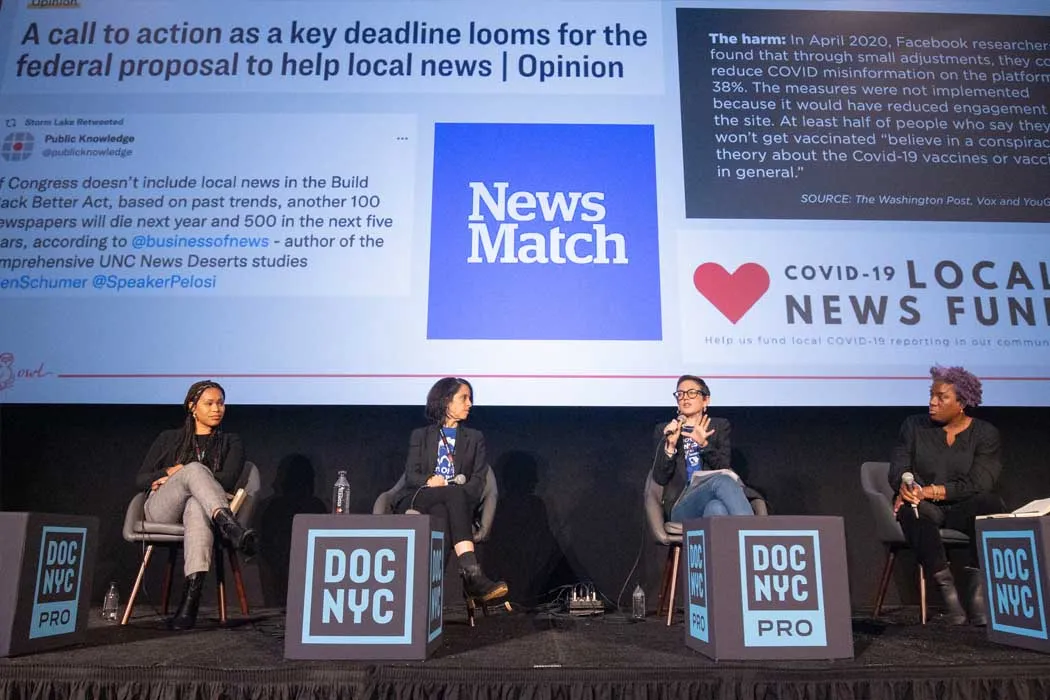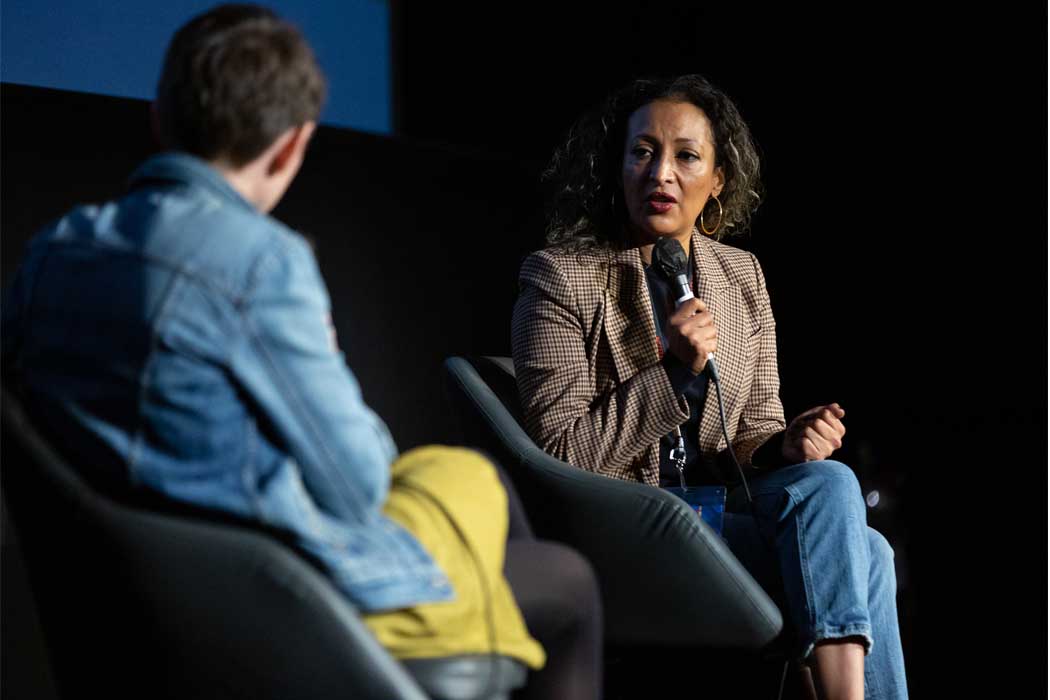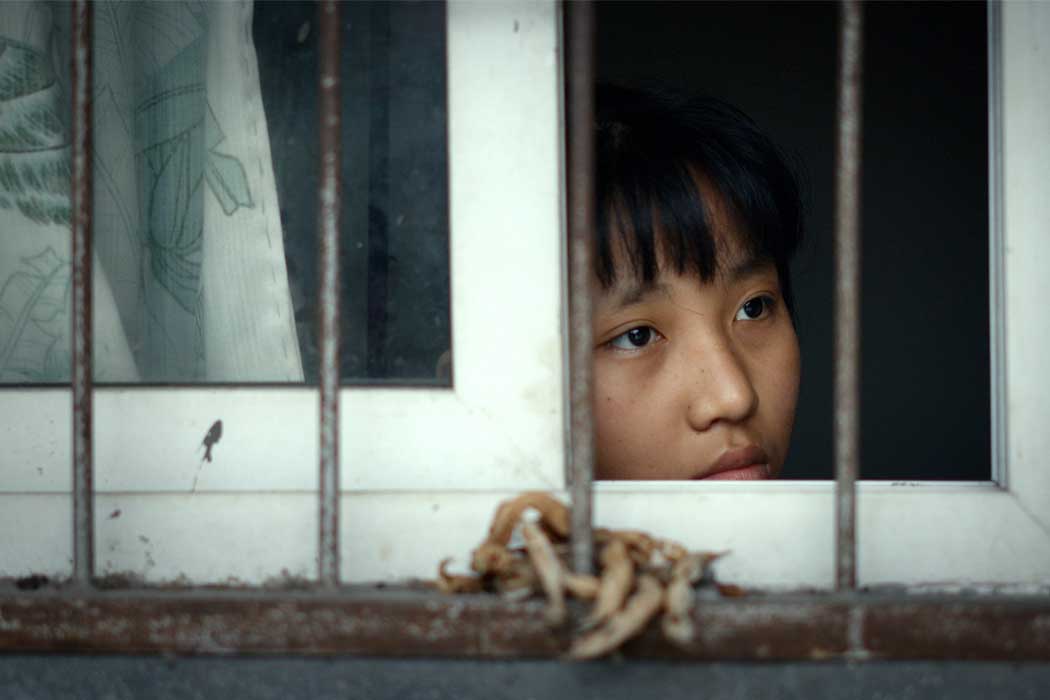

DOC NYC 2021 was back in theaters this year, with the in-person festival running from November 10-18, and then virtually through November 28. In a year when IATSE workers continue to demand more humane conditions on narrative film and television sets, documentary workers are organizing to protect themselves in less regulated, real-time production environments. The Cinematography and Producer Panels at this year’s DOC NYC Pro revealed how some members of the documentary community are responding to these growing concerns, while the programming of the festival’s International Competition addressed audiences’ demand for intimate nonfiction storytelling. The current struggle for film workers’ safety and for filmmakers to tell and control their stories were succinctly summarized by director/cinematographer Jerry Risius in the first panel on Cinematography Day: "We’re fighting for a little of our lives back."
During the "Introduction to the Documentary Cinematographers Alliance" panel with DPs Ashley Mills, Jenni Morello and Julia Liu, the DCA laid out its aims to standardize job-to-job conditions DPs have had to advocate for on their own. With membership and a working doc, which will eventually include a state-to-state rate sheet, the all-volunteer group hopes to make workplace negotiations feel less daunting. The DCA launched only two months before the panel; none of its founding cinematographers have prior organizing experience. Debate, experimentation and uncertainty, as found in the panel’s Q&A, is inherent to any daring initiative's process of becoming and to finding new answers to long untended problems—such as unpaid time for DPs in pre- and post-production, hour standards, minimum turnarounds, and safety. An audience member, referencing the recent tragic death of cinematographer Halyna Hutchinson on the set of a narrative feature, asked, "What is the DCA doing to address increasing safety concerns?" It’s a confounding question, especially for documentary DPs who fend for themselves. Whereas, for example, the Local 600 (International Cinematographer’s Guild) banned any human camera operation in passenger seats of driving cars due to safety concerns, this is still expected of DPs and operators on documentary sets, which are not as often unionized. Advocating for herself, Julia Liu refuses to film from the passenger seat and has found producers surprisingly receptive. But the onus of safety remains on her, the worker, forcing individuals to upset production etiquette just to protect themselves.
Such driving shots remained ubiquitous in documentaries at the festival, including Comala, whose director, Gian Cassini, started off doubling as the film’s DP. He eventually hired cinematographer Ivan Garcia so he could appear in the film as he confronted his family to unearth his late father’s history as a hitman. Filmmaker Kirsten Johnson, a veteran cameraperson herself, moderated the Q&A after the film’s premiere. "A lot of us would simply wonder for the rest of our lives, so I’m wondering why you kept going when you kept finding more pain?," she asked. Cassini responded, "When you’re looking for catharsis, it is always hard. I think my family dynamic is actually not unique. I started to justify my father, but there was a point when I couldn’t anymore... I realized I wasn’t going to find the truth because everyone’s truth is so tied to their point of view." Johnson then asked how Cassini’s family reacted to the film. His mom had seen it several times, he explained, "But at first she just said, 'Well, it was good.' Then after a long pause, 'But do you realize all of this has to do with fucking machismo?'" He expected more of a catharsis all around, finally conceding, "I was ashamed that it neither brought [my family] further [n]or closer."
Production on the intimate Faya Dayi inadvertently began when filmmaker Jessica Beshir started filming messages from her grandmother in Harar, Ethiopia, for her father abroad. In the Case Study panel on the cinematography of the film, Beshir said she started with a small camcorder, graduated to a DSLR (Canon 5D Mark ii), and finally acquired a cinema camera (Canon C300 Mk I, and Mk IV) after nine years of filming. Struggling to secure financing, she decided to film, produce, edit and direct the film herself. "I had many conversations with the production company of me, me and me," she half-joked. But what she didn’t have in a crew, she had in the people she filmed. "Every person you see in the film is my collaborator," she said. Literally, whoever was around held the boom pole for her—"There was always someone around." A loving portrait of her birth city, the people closest to her, and khat leaves (a euphoric stimulant chewed as a social custom), Beshir "gravitated to what felt healing” to her—healing from “being uprooted [from her birth country] in a very practical way." Due to political and economic precarity, the people of Harar wrestle with the possibility of having to leave their homes and families. "Harar is one of the most colorful places in the world; it’s almost dizzying. But that was not the story. I was looking for its interiority," she said of her choice to shoot in black and white. The form and pacing of the film were informed by the "notion of time and form that Sufis have: the labyrinthine, walled city, and the streets are all reflective of life in Harar." Many financiers and producers Beshir talked with on her journey didn’t understand the film, asking, "What are we exposing? Where are the drug lords?" Beshir forewarned the audience, "I learned that not all money is good money, and that industry standards are incredibly predatory."

Coupled with the Producing Day, the discussions between panelists and audiences fumed over the outmoded state of the industry. In the "How to Make a Living and Build a Career as a Doc Producer" panel, producer Julie Anderson stressed the importance of relationship-building for exclusive interview access and/or life rights. Audience member and filmmaker A.K. Sandhu later asked Anderson if she could reframe the advice for filmmakers without "big-name producers, name prestige, or money to offer people in exchange for exclusivity." Anderson reiterated her point while refuting the barriers. When another audience member asked about the importance of ownership and how the panelists have seen it negotiated between filmmakers, producers and distributors, producer Dan Cogan offered a surprisingly insouciant, "Who cares?" and an honest answer to the second question: "Ownership is determined by whoever puts in the most money." He went on to describe how, from 2010 to 2016, Netflix bought rights around the US. "[Then] they started buying global rights because they wanted to own everything." Now, Netflix spends less on rights and more on internal productions, owning creative properties from their inception. Cogan’s fatalistic point, in sum, was that almost no one owns their film anymore, so why should you?
I’m reminded of when Mike D. of Reelblack asked the filmmaker Haile Gerima if he felt hopeful about new Black filmmakers producing large studio films, to which Gerima replied, "Jazz is great, but who owns it? Blues is great, but who owns it? Black people have always produced the largest sugar, the largest cotton—but do they own it?" Most filmmakers do not own the rights to their films. It is common for filmmakers to have to track down whoever’s inherited their films, years later, and fight for them back. During the "Producing with Archival Footage" panel, a preservationist in the audience asked the producer of My Name is Pauli Murray, Talleah Bridges McMahon, if the crew had done anything to migrate or preserve the activist’s personal archive after using it to make the film. The question stumped McMahon, as the crew hadn’t taken measures to do so, but she was grateful for the note. After the "Impact Producing: Case Studies" panel presented two elaborate impact campaigns for John Lewis: Good Trouble, which stimulated the completion of over 54,000 voter registration forms in Georgia ahead of the 2020 US presidential election, and Storm Lake, which raised awareness for shuttering local newspapers, the question, posed by DOC NYC’s Director of Industry and Education, Mallikah Rollins, remained the lingering takeaway: "Can emerging filmmakers run an impact campaign on their own?" How practical is it to finance one when you can hardly muster the budget to finish a film?
On Doc Series day, audience members asked more difficult questions, ranging from why some studios refuse to sign NDAs to protect filmmakers’ story ideas in development, and why the DPA (Documentary Producers’ Alliance) hadn’t addressed the recurring issue of women being relegated to producer titles when their work more accurately reflected that of a second slate co-director? DOC NYC Pro audience members like Sandhu (she was a DOC NYC x VC Storytelling Incubator participant this year), often emerging filmmakers and workers, confronted panelists, veterans in their respective fields, with new questions about some of the industry’s oldest problems, shifting once familiar conversations into refreshingly uncomfortable, unknown territory. In other words, panelists and audiences were struggling to talk off-script—a positive sign, I felt, that the documentary community is eager to ditch the rails and imagine and manifest new futures for itself.
In the International Competition, Fan Jian's After the Rain (Special Mention), Iván Guarnizo's On the Other Side (Grand Jury Prize), and Gian Cassini's previously discussed Comala all feel intimate and loose of formula and encumbering infrastructure. Jian disarms his peers in After the Rain, capturing their weakness, cruelty and kindness despite deep afflictions. For over ten years, he filmed two families as they yearn to replace, by birth or adoption, the young children they lost in the 2008 Sichuan earthquake. The families’ second children, a beautiful boy and girl, cannot possibly bear the burden of replacing their siblings, but we watch them blossom anyway. In a heartbreaking scene, a father scrutinizes a video of his son’s performance at a school parade. "It’s like there’s no light in his eyes...it’s sad," he says with his son in the room. Jian then cuts to a scene of the two playing catch on the roof. Before I had time to sit with one miraculous moment, the film moved on to the next, a testament to its power if not its impatience, I initially thought. But the film’s deceptive speed blindsided me by the end; before I knew it, the film and families I’d latched to were gone. In an earlier scene, the father sees an animal off in the distance disappear almost as quickly as it emerges. He turns to Jian and says, "That’s nature. Nature is fate. Fate is seeing something you’ll never see again"—a philosophy born from trauma.

In On the Other Side, Guarnizo searches for one of the young FARC (Revolutionary Armed Forces of Colombia) soldiers who held his mother hostage for 603 days. In comparison to Jian’s tractable After the Rain, Guarnizo’s film lays out his mission and ends in a manner that suggests its completion. But Guarnizo seeks closure for no less than his mother’s trauma and passing, and to forgive the young soldier, about whom his mother wrote fondly in the diary she kept in captivity, for his compliance. The structure he imposes on the film—and due to the intensely personal nature of the material—is less convincing as a neat sequence than Jian’s imposing nothing but watching and listening, his camera’s presence enough to loosen the drama on his family's realities.
Nahid Persson befriends her protagonist, iconic journalist and activist Masih Alinejad, in her film Be My Voice, to the point of becoming a friend for her to lean on. The Iranian government arrests Alinejad’s brother, threatens her other family members, and harasses her in myriad ways to stop her from speaking out against them in the press. In Yunghong Pu’s Go Through the Dark, a father who exploits and maintains his son’s blindness in hopes that he becomes a viral, competitive Go player who can pay the bills, acclimates to Pu’s crew so much that he begins to abuse his son physically and verbally on camera. Then, the director tries to pull the wool over our eyes with a happy-ending montage. I can’t remember the last time a documentary lied to me more boldly than this film’s final shot: the father and son walking away from the camera hand in hand.
Mads Brügger finds odd companions in his latest pseudo-spy contraption, The Mole, in which the eponymous Ulrich Larsen and a fake investor, played by Jim Mehdi Latrache-Qvortrup, a former member of the French Foreign Legion, expose the ready-made template of North Korea’s illegal arms deals through the North Korean Friendship Association, or KFA, a barely veiled process of vetting DPRK minions overseas. Brügger’s plot is as ingenious as ever, but I left the film feeling more concerned about its collateral damage than its potential to tease out an embedded imperialist mechanism. The North Korean government makes all the preparations for a weapons factory to be built underneath a luxury hotel on an island in Uganda. Although the deal would displace villagers on the island, they’re told by local politicians that a hospital is being built for them. Even if the DPRK never receives the funding to carry out their now prepped and ready plan, I wonder if the energy Brügger spent was even worth getting the island community’s hopes up.
These films collapse boundaries between filmmakers and the lives they watch, influence, and sometimes directly intervene in. Other films in the International Competition maintain a certain distance from the people they film, and use that room to their advantage with more or less sensitivity. DOC NYC showed that ethical standards continue to rise for both how films are produced and how they end up on the screen. The ends never justify the means, although the latter tend to be buried. In the "Spectacular Failures and What We Learned" panel, the producers and founders shared their red flags for toxic collaborators. The co-founder of SALTY features, Yael Melamede, told the story of an abusive director who made their collaborators cry, but whose film succeeded anyway, rewarding and perpetuating abuse. Rasheem Nijhon, the founder of Culture House, suggested a simple precautionary measure: "If someone is perceived to be more powerful, or successful, let that person go." Hierarchical lines blurred for moments at DOC NYC this year, when emerging and seasoned voices took the mic to clear the room of looming powers and egos.
Aaron E. Hunt is an endeavoring filmmaker, cameraperson in production and writer with bylines in Filmmaker, Criterion, Sight & Sound, Film Comment, American Cinematographer, MUBI Notebook and more. He is also vice president of Dedza Films, a distributor for and by underrepresented filmmakers.




